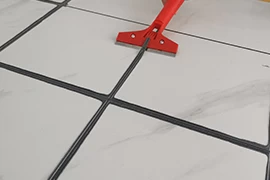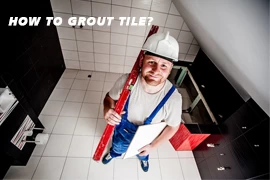How to distinguish between depression and collapse after the construction of the tile grout
At present, ceramic tile grout is still an emerging product, and many people do not know much about it. So some owners found that the effect of the grout was not flush with the tile after the completion of the application, and they thought that the tilers were not done well or there was a problem with the material, and there was a collapse problem. In fact, the effect of the finished product is that the surface of the grout is slightly lower than the surface of the ceramic tile, and into a groove. Collapse and sag must be distinguished. Below, Kelin flexible grout additive manufacturer tells you the difference between a sag and a collapse.

It is normal to have grooves in the tile grout finished products, and it is not a quality problem. This is to extend the service life of the tile grout and protect the ceramic tiles. The surface of the tile grout is slightly lower than the surface of the ceramic tile, which can reduce the daily trampling, scraping and other wear and tear. Flat and grooved shapes are made because of the different products and tools used. For example, scraper is used when making waterborne epoxy adhesive, so the tile grout made by epoxy colored sand is flush with ceramic tile. The tile grout and filling have a small amount of unfilled, but also to a certain extent to meet the ceramic tile joints, heat expansion and cold contraction principle. There are certain depressions, and it is related to the tools used for pressing the joints. During construction, the joints division generally uses pressing balls or tungsten steel pressing plates to press the seams. This kind of pressing tool has a radian, so the effect of pressing the seams is grooved. In this way, the tile grout and the residual material can be clearly separated, so that the residual material can be easily separated when the edge is clear.

After making the tile grout, the phenomenon of collapse is because the speed is too fast, the filling of the tile grout not uniform, or because the sealant is too thin. When playing the tile grout, the tile grout and the gap contact is not complete, resulting in internal hollow, pressure after the joint will collapse, will also be accompanied by the phenomenon of bubbles. If the material is too thin, for deep cracks, after the pressure joints, the sealant gradually sinks, and eventually sinks to the bottom of the ceramic tile, and when solidification occurs, the phenomenon of collapse will appear. If the material is too thin, for deep cracks, after the pressure seam, the sealant gradually sinks, and eventually sinks to the bottom of the ceramic tile, and when solidification occurs, the phenomenon of collapse will appear. And if it is in the wall construction, the material is too thin to play tile grout will flow down. Therefore, when playing tile grout, we must pay attention to it. If we find that the material is too thin, we should replace it and do not use it.

High quality tile grout will not collapse, hanging the situation, so we should also polish your eyes in the selection of products. That's the difference between a tile grout collapse and a sag. Have you learned it?

 +86 15140071761
+86 15140071761 sales@tilegrout.net
sales@tilegrout.net













